The divorce rate in Australia has decreased in the last 2 years, but so has the number of registered marriages. The COVID-19 pandemic is the primary reason for this drop in numbers. Other factors include changes in how people approach marriage and reasons for divorce.
This study provides insight into Australian marriages, weddings, and divorce. Read on to find data and trends about this complex subject.
Summary of marriage and divorce statistics
- Data from 2020 shows there were 78,989 marriages, a 30.6% decrease from the year prior
- The average marriage lasts for 12.2 years in Australia
- Census data shows there were 49,510 divorces in Australia
- Divorce rate has decreased to 1.9 from 2.6 divorces granted per 1,000 people
- The most common age for getting a divorce is 45.5 for males and 42.9 for females
- 1 in 5 children grow up in a single-parent household
Australian marriage and wedding statistics
The number of marriages in Australia decreased significantly in the past year. Registered marriages have seen a slow climb in the past decades, but the recent decrease is the largest ever recorded by the Australian Bureau of Statistics (ABS).
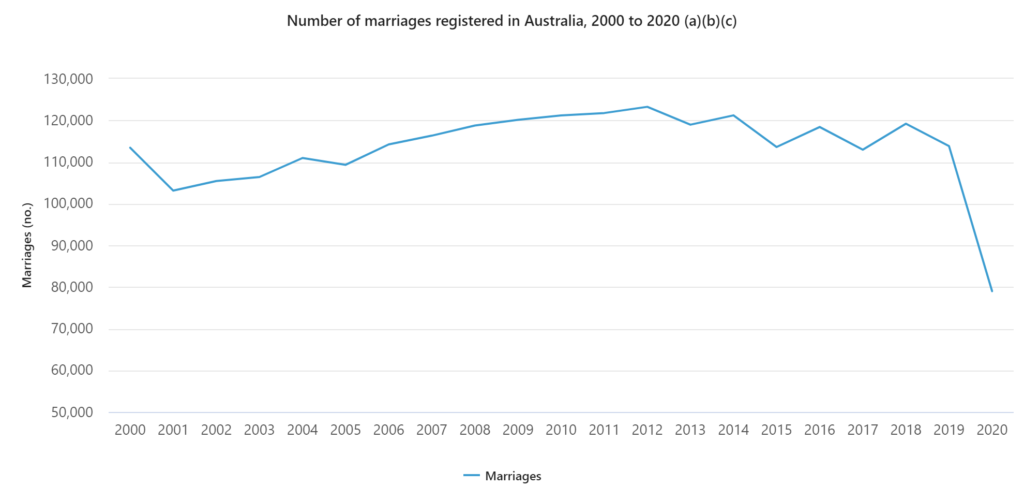
The pandemic is the most cited reason for this drop in numbers. Despite this, a surge of delayed marriages is expected once restrictions have been lifted. More couples are cohabiting and planning their marriages with greater care. Further data shows that:
- There were 78,989 marriages registered in Australia in 2020, which is a 30.6% decrease compared to data taken prior to the pandemic (113,815).
- Restrictions put in place during the first year of the COVID-19 pandemic had a direct impact on marriages. These restrictions include social distancing requirements, size limits on gatherings, and travel restrictions.
- These restrictions had a significant impact on the planning and celebration of weddings, postponing marriages.
- The proportion of civil versus religious ceremonies remained comparable with previous years.
- The median age at marriage has steadily increased between both males and females.
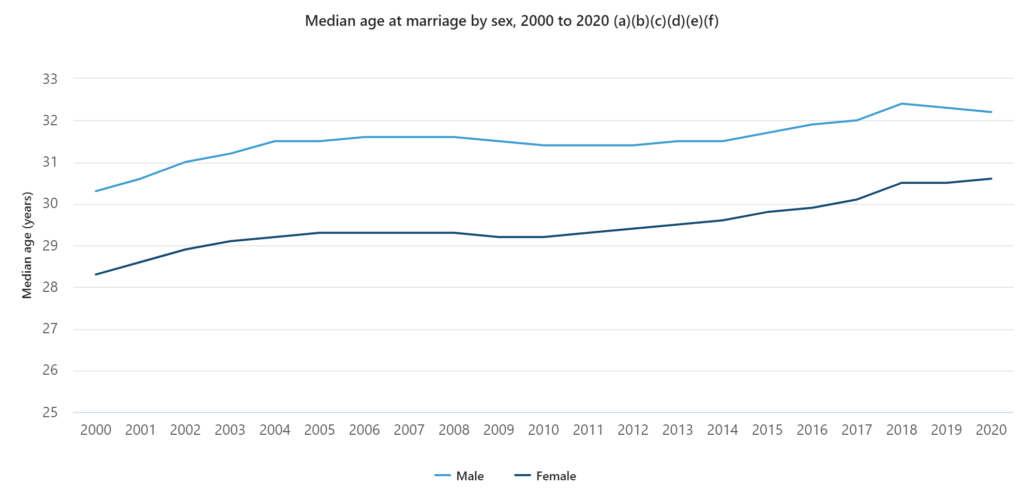
Data included in the above chart includes people marrying for the first time and those marrying again. Participants who did not identify themselves as either male or female were excluded from the results presented.
Australian wedding costs
The high costs of weddings can deter couples who are looking to get married on a budget or are concerned about their financial stability going forward. While the pandemic is still the main reason for dropping marriage numbers, rising costs play a role too.
The Australian Wedding Industry Report estimates the average final cost of a wedding in Australia to be between $31,300 and $32,500. The average starting budgets are about $21,000. Couples plan for a final wedding cost of $25,000. Estimated costs include:
- Wedding venue – $13,785
- Dress – $2,385
- Catering – $4,530
- Celebrant – $780
- Videography – $2,570
- Wedding hire – $2,425
- Wedding photography – $2,990
- Formal wear – $1,420
- Wedding flowers – $1,915
- Wedding music – $1,625
- Wedding invitations – $625
- Wedding cakes – $545
- Wedding cars – $1,045
- Decorations – $1,245
- Bridesmaids – $665
- Hair and makeup – $885
- Photo booth hire – $920
- Bomboniere – $385
Other costs can include the honeymoon, travel, lodging for guests, and additional attractions or events at the wedding. These vary greatly depending on the type of wedding and the couple’s budget.
What is the divorce rate in Australia?
The divorce rate in Australia is 1.9 divorces per 1,000 people. The introduction of “no-fault divorce” under the Family Law Act lowered the crude number of divorces from 4.6 to just 2 (per 1000).
In the 70s, there were 63,230 recorded divorces in Australia out of a population of 14 million people. The current population increased to 24.6 million, but the number of divorces dropped to 49,032. This trend suggests a shift in how people approach relationships and divorce.
A decreasing divorce rate in Australia is the result of:
- Fewer people getting married
- More couples cohabiting before marriage
- The average marriage age increases
- More careful selection of marriage partners
- Financial stability is greater for married couples, so couples stick together
These factors indicate a shift in customs for relationships, including more acceptance of people cohabiting and not marrying. This also includes a higher tolerance for single-parent households. The trends here match worldwide changes in attitudes about relationships, marriage, and divorce.
What is the major cause of divorce in Australia?
According to the Australian Divorce Transitions Project, the number 1 cause of divorce in Australia is “affective issues”. Affective issues are broadly split between the following 3 areas:
- Communication problems
- Loss of connection
- Infidelity/trust issues
Communication was the most cited reason amongst the three. Other causes of divorce in Australia include:
- Physical or emotional abuse
- Alcohol and drug abuse
- Financial problems
- Work/time pressures
- Family interference
- Physical health or mental health issues
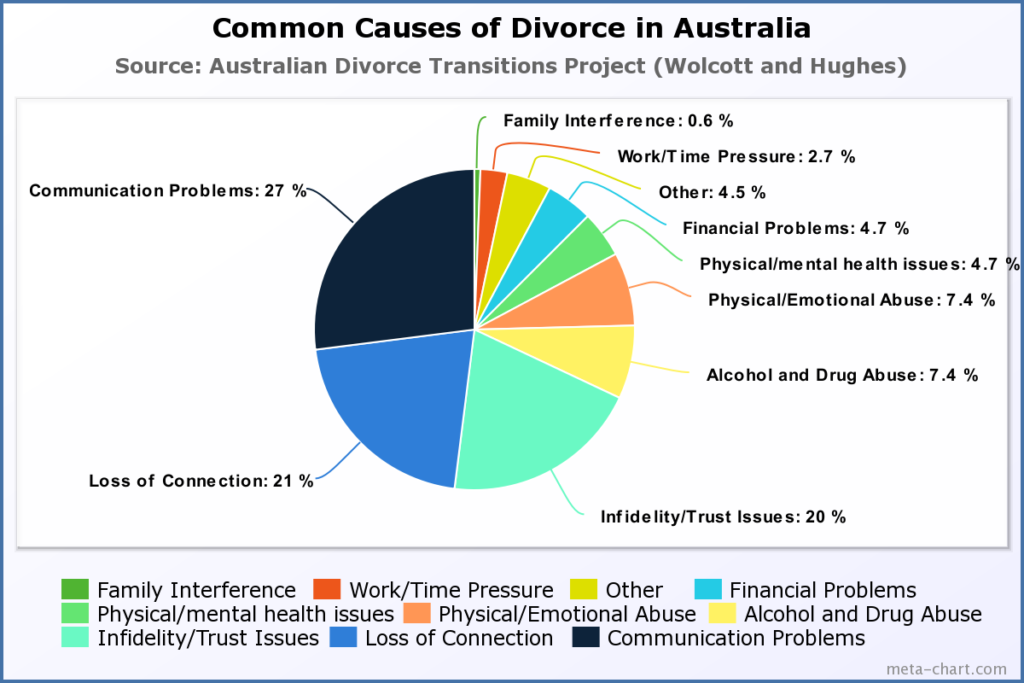
The average divorce rate in Australia broken down
Divorce in Australia can be broken down in a number of ways to paint a bigger picture. These include looking at data based on age and gender, ethnic backgrounds, whether children are involved in the marriage, and same-sex divorce rates.
Divorce rate in Australia by age and gender
Divorce rates in Australia are highest between both males and females 40-49 years of age, and lowest for both younger and older males and females. Younger people tend not to be married long enough to come to divorce as an option, and older people feel their relationship is established and reliable.
- For males, the highest divorce rate was for those in the 45-49 year age group, with 9.4 divorces per 1,000 in that age group.
- For females, 40-44-year-olds had the highest divorce rate, with 9.4 divorces per 1,000.
- Divorce rates were higher for females than males under 45 years old.
- Divorce rates were higher for males than females 45 years old and up.

Australian divorce rate based on migrant background
The ABS collects data on divorce rates for ethnic groups and individuals with migrant backgrounds in Australia. Recent findings show that migrants from North-West Europe (the United Kingdom specifically) have the highest number of divorces in Australia among migrants.
Females from South-East Asia and North-East Asia greatly outnumbered males in divorces. However, European, North African, and Middle Eastern males outnumbered females in divorces. Other regions were closer in proportion between males and females.
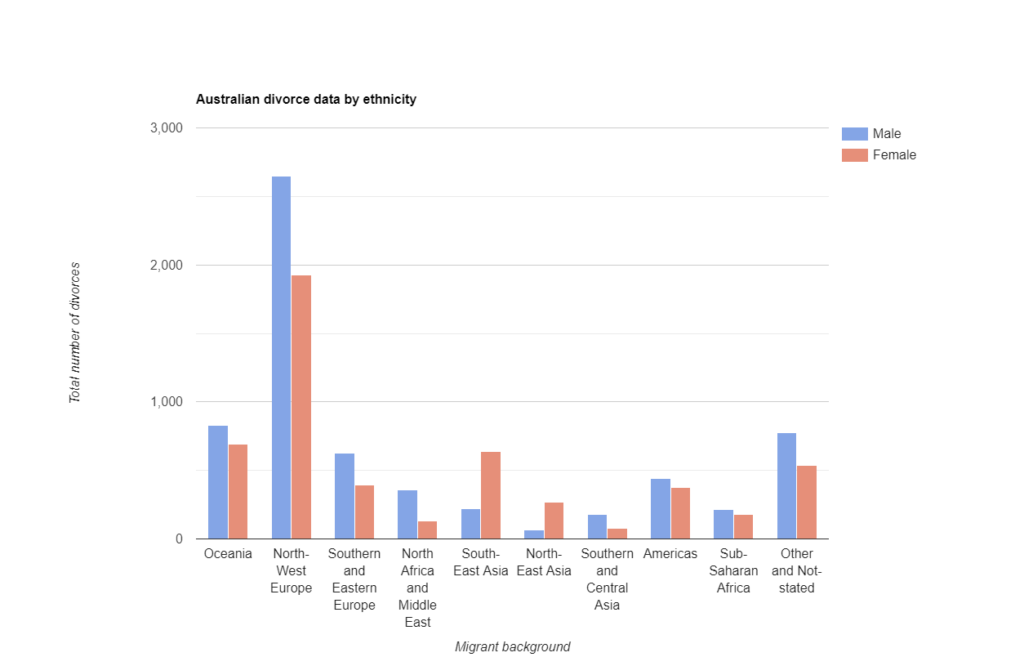
The exact numbers of divorces can be broken down into the following numbers. This data represents total numbers taken from individual regions:
| Ethnic background (totals) | Male | Female |
| Oceania | 827 | 694 |
| North-West Europe | 2,648 | 1,925 |
| South-East Europe | 628 | 391 |
| North Africa and the Middle East | 359 | 129 |
| South-East Asia | 222 | 637 |
| North-East Asia | 68 | 270 |
| Southern and Central Asia | 178 | 79 |
| Americas | 444 | 376 |
| Sub-Saharan Africa | 215 | 178 |
| Other and Not Stated | 775 | 534 |
The average age of divorce for migrant males is 44.2 years of age. Females are slightly younger, divorcing at 41.3 years of age. Females initiated divorce most often followed by both partners applying together. Males were the lowest types of applicants to initiate divorce:
- 13,216 males applied for divorce
- 18,571 females applied for divorce
- 16,172 joint males and females applied for divorce
Data did not specify information about same-sex relationships and divorces, or whether children were involved.
Divorces between parents who have children 17 and under
Divorces between parents who have children fell since the introduction of the Family Law Act of 1975. The Family Law Act focuses on the rights of children and the responsibilities that each parent has towards their children, rather than on parental rights.
Prior to this law, 67.6% of divorces involved children under 18. This has fallen to 47.1% in 2017 according to the ABS. Additionally, the divorce rate among couples with children was 40% lower than couples without children.
Data shows that 1 in 5 children in Australia currently grows up in single-parent environments. Information on the number of children per divorce shows the following:
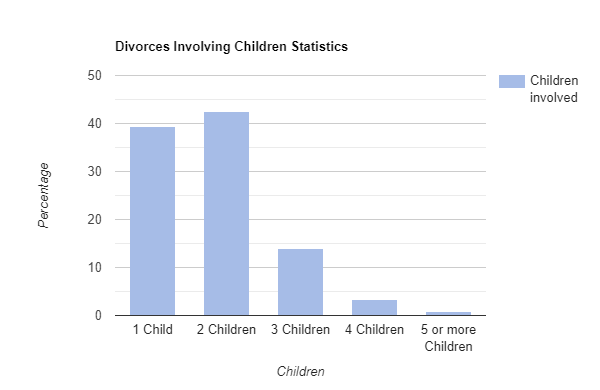
- 39.4% involved one child
- 42.4% involved two children
- 14% involved three children
- 3.4% involved four children
- 0.8% involved five or more children.
The latest statistics show that 23,069 divorces included at least one child aged 17 or younger.
Divorce rate in Australia by state
Based on 2019 information provided by Statistia, the crude divorce rate in Australia was highest in Queensland but lower in the Northern Territory:
- Queensland – 2.3
- Western Australia – 2
- South Australia – 1.9
- Tasmania – 1.8
- Victoria – 1.8
- New South Wales – 1.8
- Northern Territory – 1.5
However, population density can skew the divorce rate. In 2019, the most divorces in Australia took place in New South Wales:
- New South Wales – 14,393
- Victoria – 11,861
- Queensland – 11,575
- Western Australia – 5,145
- South Australia – 3,394
- Australian Central Territory – 1,394
- Tasmania – 985
- Northern Territory – 369
The Northern Territory still has the fewest number of divorces, whereas Queensland dropped in the rankings.
What are the marriage rates and divorce rates for same-sex couples in Australia?
Prior to the legalization of same-sex marriage in Australia in 2017, data from the ABS shows that around 46,800 same-sex couples were living together, 0.9% of all Australian couples. Since then, marriages between same-sex couples saw an initial surge, but have since decreased:
- The most recent data shows that there were 2,902 same-sex marriages. This is a decrease of 2,605 (47.3%) from the previous year.
- In the year before that, same-sex marriages decreased by 1,031.
- Same-sex marriages represented 3.7% of all marriages registered in Australia.
- More female same-sex couples were married (61.4% of all same-sex marriages) than male same-sex couples (38.5%) across all states and territories
- The median age for males was 37.2 years, and 35.3 years for females. This has decreased since the previous data collection
- 97.1% of marriages were administered by a civil celebrant
Couples were simultaneously able to access the Australian divorce system when same-sex marriage was legalized. Resources for divorces amongst same-sex couples are not yet available because of how recent the legalization of same-sex marriage was.
The 2019 data shows there were 104 divorces between same-sex couples. 34 of these divorces were between male couples, and 70 were between female couples. Divorces between same-sex couples seem to be following national trends.
FAQs about the divorce rate in Australia
Below we address some of the most frequently asked questions about the divorce rate in Australia to give you better insight into marriages and divorces in Australia.
What is the #1 cause of divorce in Australia?
The most cited reason for divorce in Australia is affective issues. Communication problems between couples are most often the cause of divorce, but the loss of connection and infidelity follow closely.
This is different from other countries around the world where infidelity is most often the stated cause for a couple to separate.
What qualities make a relationship successful?
Studies that focus on long-term marriages and relationships commonly cite the following elements as essential criteria for a successful and happy partnership:
- Mutual respect and appreciation for one another
- Trust and faithfulness
- Physical contact and sexual intimacy
- Strong communication skills
- Open discussions of problems
- Shared values and beliefs
- Support for one another
- Cooperation in good times and bad
- Flexibility in changing situations
How do Australia divorce rates compare to the rest of the world?
The divorce rate in Australia is favorable to other nations. Whereas the divorce rate can be as high as 5.52 divorces per 1,000 inhabitants per year in the Maldives, Australia’s 1.9 shows a much more stable situation. Most recent worldwide statistics show the following divorce rates:
- Maldives – 5.52
- Kazakhstan – 4.6
- Russia – 3.9
- Belarus (tie) – 3.7
- Belgium (tie) – 3.7
- Moldova – 3.3
- China – 3.2
- Cuba – 2.9
- Ukraine – 2.88
- United States – 2.7
Do second marriages have a higher rate of divorce?
While only 30% of first-time marriages end in divorce, up to 60% of second marriages end in divorce in Australia. This trend matches up with worldwide statistics about the divorce rate for subsequent marriages.
Although second marriages have a higher chance of ending in divorce, dating after divorce is common and many people find happiness with another partner. Don’t let the statistics discourage you from trying to move on with your life and find love again.
Final thoughts on the divorce rate in Australia
As the number of marriages drops in Australia as a result of the pandemic, the divorce rate sees a similar yet not as sharp decrease. Couples are postponing their marriages, and a surge in weddings is expected after the pandemic. It is yet to be seen whether divorces will follow suit.
Even with dropping numbers, the impact of divorce on spouses and children remains the same. Separated couples face the trauma of managing a broken marriage, and children suffer seeing their parents separate. Financial stability also drops for divorced couples, making it harder to manage money-related issues.
One way to avert some of the risks for divorce is by not rushing into marriage, but also taking time to financially plan out your future together. Cohabiting is also a way to test a relationship before marriage to see if a couple is compatible in the long run.